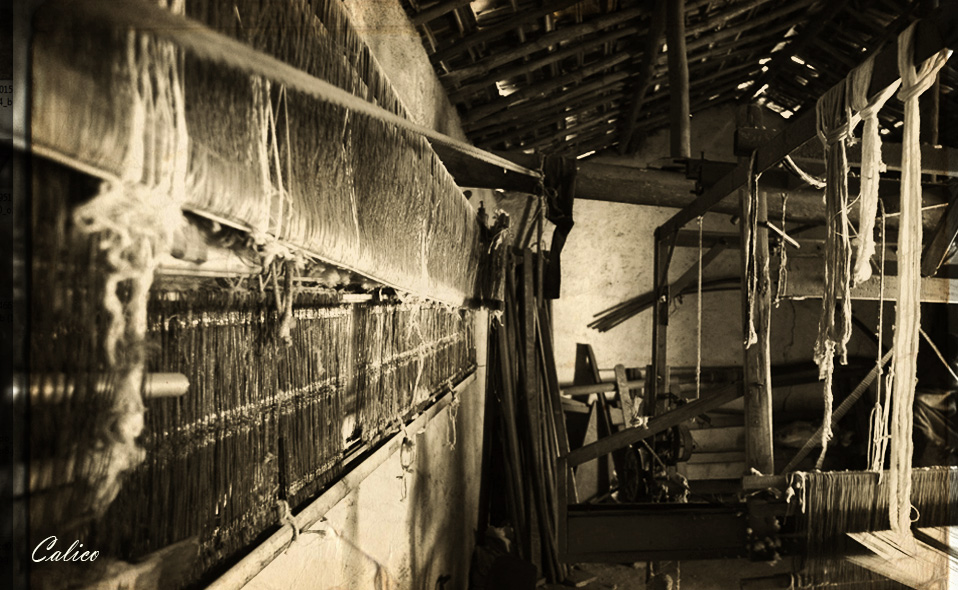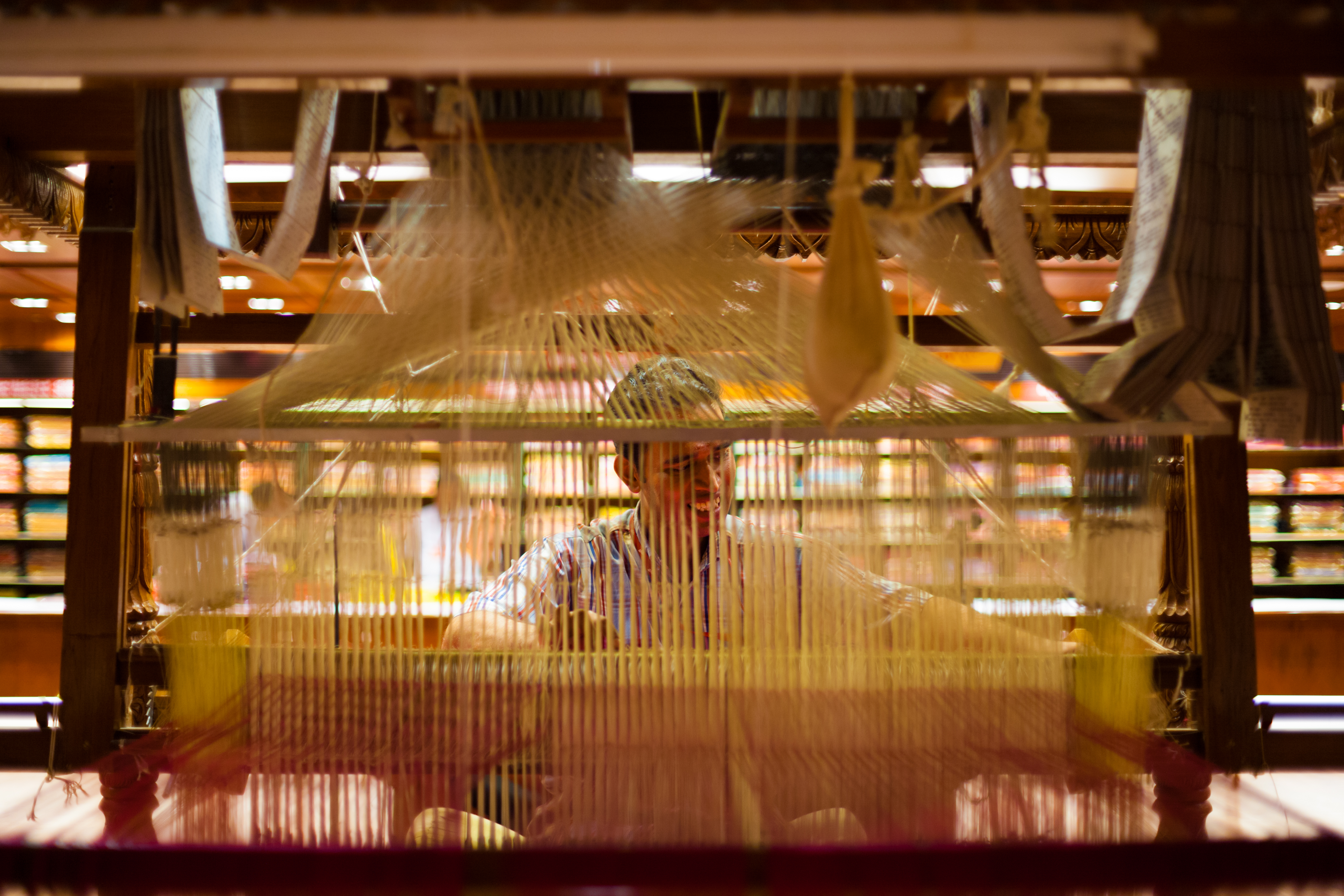What is Handloom?
Handloom refers to wooden frames of different types which are used by skilled artisans to weave fabrics usually from natural fibers like Cotton, Silk, Wool, Jute etc. It is a cottage industry where the entire family is involved in the production of cloth. Right from spinning the yarn, colouring, to weaving on the loom if done by them. Fabric produced from these looms is also referred to as Handloom.
The tools required for this entire process are made from wood, sometimes bamboo and they do not require any electricity to run them. The entire process of fabric production was totally manual in earlier times. Thus this is the most eco-friendly way of producing clothes.
History of Handloom – Early Days
Indian Handloom dates back to the Indus valley civilization. Even in ancient times, Indian fabrics were exported, Rome, Egypt and China.
In earlier times, almost every village had its own weavers who made all the clothing requirements needed by the villagers like sarees, dhotis, etc. Some areas where it is cold in winter there were specific wool weaving centers. But everything was Hand-Spun and Hand-Woven.
Traditionally, the entire process of cloth making was self-reliant. The cotton / silk / wool came from the farmers, foresters or shepherds, and the cotton was cleaned and transformed by weavers themselves or agricultural labour community. Small handy instruments were used in the process, including the famous spinning wheel (also known as Charkha), mostly by women. This hand spun yarn was later made into cloth on the handloom by the weavers.
Decline of Handloom
During British rule, India was turned into an exporter of raw cotton and the country was flooded with machine made imported yarn. To increase consumption of this yarn, British authorities resorted to violence and coercion. Summarily, this resulted in a complete loss of livelihoods first for the spinners, and dependence of handloom weavers on machine yarn.
When yarn came from a distance and had to be bought, yarn dealers and financiers became necessary. And as the average weaver had little credit, the industry fell more and more into the grip of middlemen. thus the independence of most weavers disappeared, and a great majority of them came to work for a Trader on contract/ wage basis.
Despite this Indian handloom sustained itself, until World War 1 when imported machine made clothes flooded the Indian Market. The beginning of Powerlooms in the 1920’s, and the consolidation of the mills and the high cost of yarn, made an unfair competition that led to the decline of Handloom.
Revival of Handloom
Mahatama Gandhi started the Swadeshi Movement and reintroduced hand spinning in the name of Khadi which essentially means hand spun and hand woven. Every Indian was urged to spin the yarn using Charkhas and wear Khadi. This led to the closure of the Mills in Manchester and huge turning point in the Indian independence movement. People burnt imported clothes and chose to wear Khadi.

Handloom – Post Independence
Post Independence, textile mills and spinning mills continued to function in India. Today, there are many weaving styles that use machine spun yarn and these fabrics are referred to as Handloom. And fabrics made from Handspun yarn are called Khadi fabrics.
Though the textile and spinning mills continued in Independent India, handloom / khadi were given a lot of protection from unfair competition. Thus the fabric was widely used and affordable for everyone.
Current Scenario
Since 1985, and especially post 90’s liberalisation, handloom sector had to face competition from cheap imports, and design imitations from powerlooms.
In addition government funding and policy protection also declined drastically. Also the cost of natural fiber yarn has increased tremendously. In comparison to artificial fiber, the cost of natural fabric has gone up. This makes it unaffordable for the common people. But the wages of handloom weavers have remained frozen for the past decade or two.
Unable to compete with cheaper poly-mixed fabrics, many weavers are quitting weaving and going for unskilled labour work. And many have been reduced to extreme poverty.

Handloom is Timeless
Handloom is a beautiful fabric and special as no two fabrics can be alike. Of course the output depends on the skill set of the weaver. But even if we make two weavers with similar skills weave the same fabric it will be different in one way or the other. Each fabric is a reflection of the weaver’s moods – when a weaver is angry the fabric would be little tight while it would be lose when he is sad. Thus each piece is unique in itself.
In India there are different styles of weaving in different parts of the country, and sometimes in the same region there could be as wide a range as 20- 30 varied styles. From simple plain fabrics, Tribal motifs, geometric designs, tye and dye, to exhaustive art on muslin. Our weavers have been master craftspeople. No other country can boast of such exclusive wide range of rich textile art, even today.
Just like paintings and photographs, each woven sari is a masterpiece. Saying that handloom must perish for its time consuming and laborious compared to powerloom, is like saying painting, photography, clay modelling will go obsolete because of 3d printers and graphic designs.
Let us save this timeless tradition…support Handloom! We are trying to do our bit. You too can do it – Buy handloom sarees online.
what a grate content, i really liked your content. i am a regular visitor of your website, please keep writing.
Thanks…Glad you like our blog.
Truly handloom is priceless. What an amazing piece of information shared on handloom sarees. I really over this post. Get to k ow very interesting facts. Loved it!
Handloom Sarees online
Thanks
Excellent, in remote villages of Bengal you can still see these in action.
Nice blog information & thank you for sharing this useful content. For more designed Handlooms and artificial jewellery
It’s remarkable in favor of me to have a site, which is beneficial in support of my knowledge.
thanks admin
Glad you like the blog…thanks.
Hey!!
I have been following your content and I admire how thoughtful and well drafted your blog is. I have been working with a brand called Jhumoor http://www.jhumoor.com that sells authenticate handloom sarees from Bengal.
We we absolutely love to feature on your blog and feature you on ours. You can also check our blog at https://jhumoor.design.blog/.
Keep up the good work.
Looking forward to hear from you.
Have a great day!!!